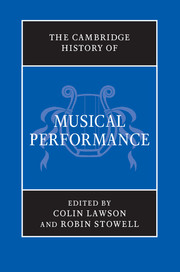Book contents
- Frontmatter
- PART I PERFORMANCE THROUGH HISTORY
- PART II PRE-RENAISSANCE PERFORMANCE
- PART III PERFORMANCE IN THE RENAISSANCE (C. 1430–1600)
- PART IV PERFORMANCE IN THE SEVENTEENTH CENTURY
- PART V PERFORMANCE IN THE ‘LONG EIGHTEENTH CENTURY’
- PART VI PERFORMANCE IN THE NINETEENTH CENTURY
- PART VII THE TWENTIETH CENTURY AND BEYOND
- 28 Musical performance in the twentieth century and beyond: an overview
- 29 Vocal performance in the twentieth century and beyond
- 30 Instrumental performance in the twentieth century and beyond
- 31 Case study: Karlheinz Stockhausen, Gruppen für drei Orchester
- PART VIII
- Index
31 - Case study: Karlheinz Stockhausen, Gruppen für drei Orchester
from PART VII - THE TWENTIETH CENTURY AND BEYOND
Published online by Cambridge University Press: 28 March 2012
- Frontmatter
- PART I PERFORMANCE THROUGH HISTORY
- PART II PRE-RENAISSANCE PERFORMANCE
- PART III PERFORMANCE IN THE RENAISSANCE (C. 1430–1600)
- PART IV PERFORMANCE IN THE SEVENTEENTH CENTURY
- PART V PERFORMANCE IN THE ‘LONG EIGHTEENTH CENTURY’
- PART VI PERFORMANCE IN THE NINETEENTH CENTURY
- PART VII THE TWENTIETH CENTURY AND BEYOND
- 28 Musical performance in the twentieth century and beyond: an overview
- 29 Vocal performance in the twentieth century and beyond
- 30 Instrumental performance in the twentieth century and beyond
- 31 Case study: Karlheinz Stockhausen, Gruppen für drei Orchester
- PART VIII
- Index
Summary
At its world premiere, 24 March 1958, there would have been every reason to expect that future performances of Karlheinz Stockhausen's Gruppen for three orchestras would, at the very most, be extremely rare events. Gruppen should last for about twenty-five minutes – a relatively brief duration given the considerable instrumental resources which go into making it. The work is written for a total of 109 players. These include four flutes and one alto flute, three oboes and two cors anglais, an alto and a baritone saxophone, eight horns, six trumpets, seven trombones – five tenor, one bass and one contrabass – tuba and twelve percussion players as well as keyboard glockenspiel, celesta, piano, two harps, a large string section and an electric guitar. On its own this would be an orchestral line-up that could outpace even the excesses of some of the later Romantics, though here it is at the service of 1950s high modernism. But the most obviously and immediately demanding aspect of this extraordinary work is the splitting of this considerable range of performers into three roughly equal groups, each with its own conductor and placed to the front, left and right of the audience. This arrangement requires a space both large enough and with the flexibility to accommodate this highly individual orchestral disposition, which tends not to be most modern concert halls. Either an adaptable arena (and with a suitable acoustic) has to be found (let alone paid for) or an existing concert hall, if its architecture allows, has to be fitted out with some kind of temporary staging.
- Type
- Chapter
- Information
- The Cambridge History of Musical Performance , pp. 798 - 814Publisher: Cambridge University PressPrint publication year: 2012



